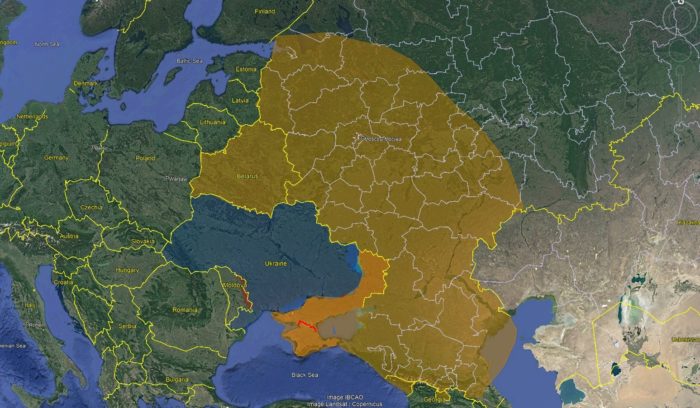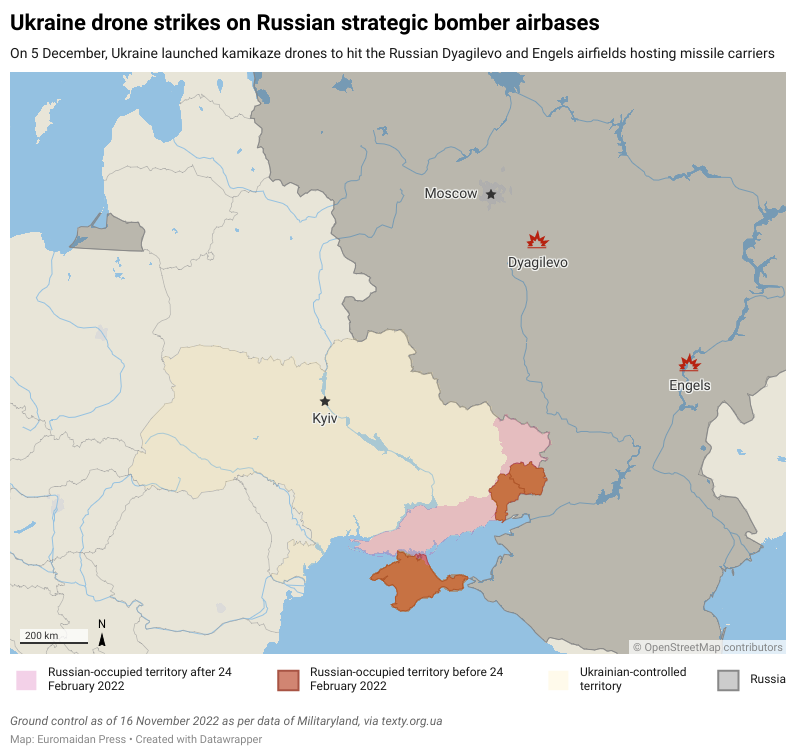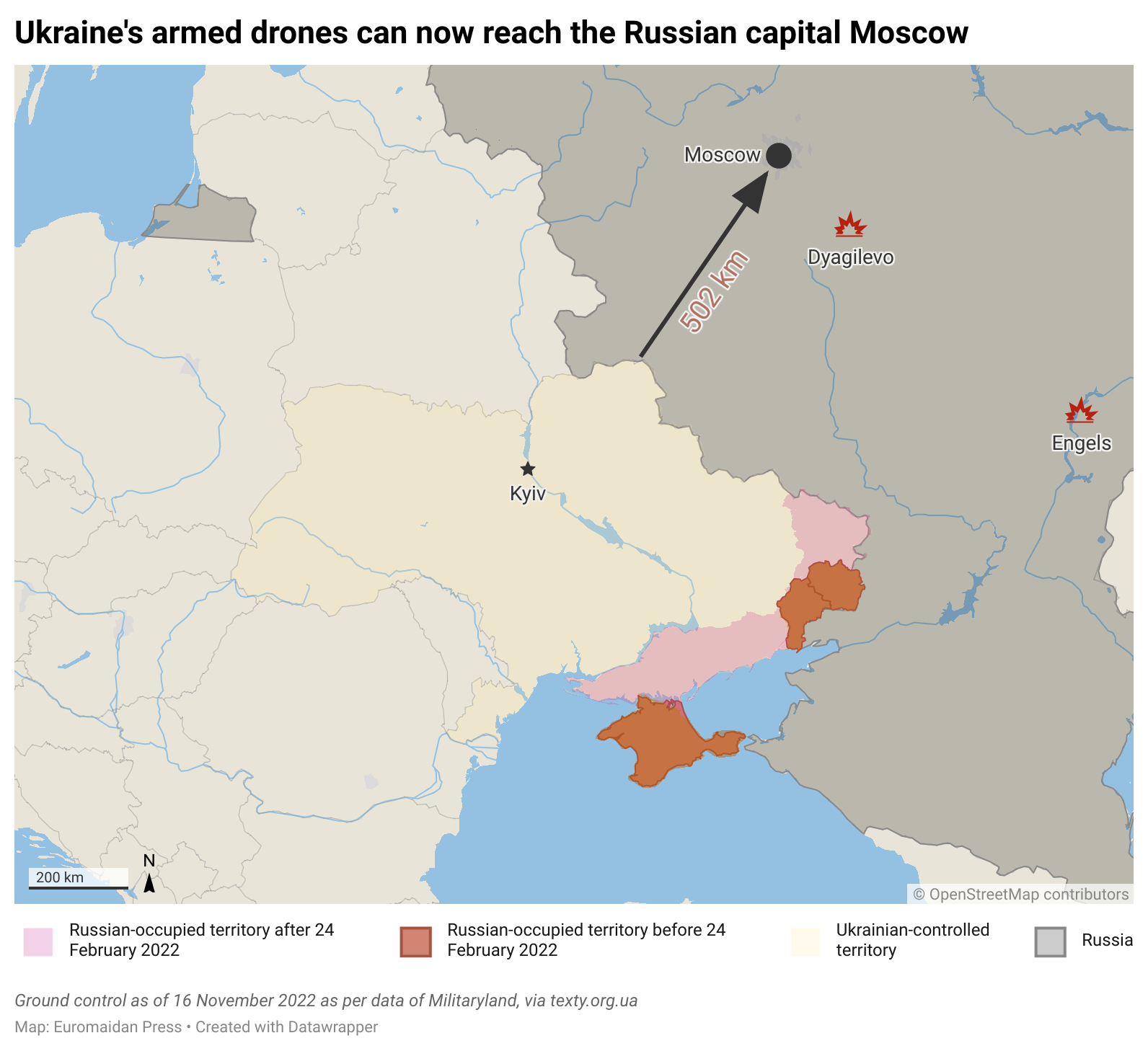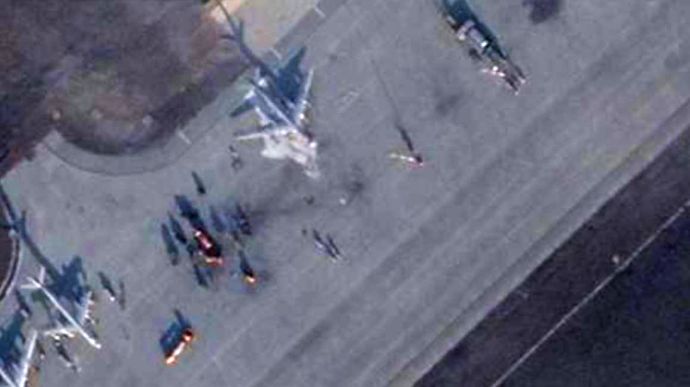The Russian strategic airbases in Dyagilevo and Engels have become the most distant targets hit by the Ukrainian Armed Forces during the nine-month-long war.
Aftermath if the alleged Ukrainian strike at the Engels airbase, Dec 4th/Dec 6th @planet images comparison. Several fire trucks and a foam beneath Tu-95 is clearly visible (also I'd say some craters, but I'm not 100% sure). pic.twitter.com/EkJMKKzpdY
— Mark Krutov (@kromark) December 6, 2022
The December 5th Ukrainian strikes on the Russian rear more than 700 km from Ukraine make military experts all over the world wonder what weaponry stands behind such brazen attacks. Whatever weapon has been used, it is definitely a game changer in the war. Ukraine's ability to reach targets within the operating range of around 1,000 km means that the Russian capital Moscow can now be hit from Ukrainian territory.

Back in November 2022, Ukraine's state defense corporation Ukroboronprom announced the final production stage of new Ukrainian unmanned aerial vehicles (UAVs) capable of carrying 75 kg of explosives with an operating range of around 1000 km. Currently, the production of these UAVs is one of the most mysterious projects of the Ukrainian arms industry. It is highly likely Ukraine may have employed its newly produced UAVs to hit the Russian strategic airbases on 5 December 2022.
Ukrainian 1000-km range suicide drone passes number of tests
On the other hand, Ukraine might as well have chosen another path by adapting old Soviet UAVs to modern needs. The Ukrainian OSINT group Defense Express asserts that the modernization of Tu-143 and Tu-141, Soviet-era armed drones designed back in the 1970s and 1980s, seems to be a reasonable and cheap option for Ukraine today. Both of these drones have jet engines and can fly at a low altitude (up to 10 meters high) with a transonic speed of 950-1100 km/h. The operating range of Tu-143 is 200 km, while Tu-141 can reach targets within a much bigger range. There has been an unknown quantity of such drones in service with the Ukrainian Armed Forces since 2014.
Russian military bloggers speculate that the Ukrainian Armed Forces already used Tu-143 unmanned vehicles as kamikaze drones to hit the airfield in Millerovo (Rostov Oblast, western Russia) in October 2022. With an operating range of about 1000 kilometers, the strikes at the Russian strategic airbases in Dyagilevo (more than 400 km from Ukraine) and Engels (more than 700 km from the Russo-Ukrainian border) would have been well within the capacity of the old Soviet drones Tu-141.

The surveillance camera footage that recorded the attack on the Russian strategic airbase in Engels on 5 December certainly provides food for thought. The camera was installed in the apartment building located within 5,5 km from the airfield. A distinct sound of a flying object can be retrieved from the audio. Just some 25 seconds after the sound kicks in, the explosion at the airfield can be heard.
Three things Ukrainian drone strikes on Russian strategic airbases change in the war
Although the exact trajectory of the unidentified flying object that hit the Russian airbase is unknown, based on the distance between the airfield and the apartment building where the surveillance camera was installed, one can calculate the approximate speed of the UAV. Whatever hit the Russian bomber aircraft at the airfield in Engels, it reached the speed of 220 m/s or 792 km/h just before the strike. Therefore, such an aerial vehicle might have had a jet engine and moved at high speed and at a low altitude -- meaning that it could have been a long-range missile.
Ukraine's top generals have stressed
that Ukraine needs long-range missiles to win the war against Russia, and such a program is already in the works, as physics researcher Dr. Oleksandr Marchenko explained in an interview with Euromaidan Press.
Ukraine needs long-range missiles to really win the war, country’s top generals say
Despite the fact that it is not clear what armed drones (or missiles) Ukraine employed to attack the Russian airfields on 5 December, the ability of the Ukrainian forces to strike within the operating range of 1000 km has a strategic impact on the Russo-Ukrainian war. Before these long-range drone strikes on the Russian strategic airbases, only Russia could hit targets this deep in the enemy's rear, including Ukraine's capital Kyiv.

From now on, Ukraine is able to attack the Russian capital Moscow. Whether the Ukrainian Armed Forces plan to resort to such an option in the future is unclear. However, the very possibility of a devastating strike at the military infrastructure in Moscow as retaliation for the Russian missile attacks on the critical civilian infrastructure in Ukraine might have a sobering effect on Russia's leadership.
Related:
- Three things Ukrainian drone strikes on Russian strategic airbases change in the war
- Drones attack Russian classified plant 80 km from Ukrainian border
- Russia claims Ukraine targeted its remote airfields with UAVs; Ukraine neither confirms nor denies
- Explosions reported in airfields of strategic aviation bases of Russia
- Recent strikes show Ukraine can conduct long-range operations on Russia without western equipment -FT
- Ukraine’s air defense improved fourfold since start of Russian invasion
- Ukraine needs capability to attack Russian territory - Lt. Gen. Ben Hodges
- Ukraine needs long-range missiles to really win the war - top generals
- What weapon Ukraine might have used to hit airfield in Crimea





